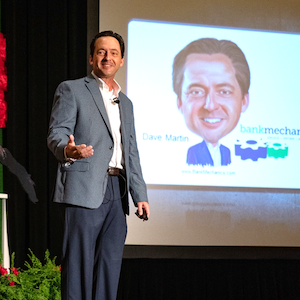 |
 |
It's not what you're capable of. It's what you're willing to do. » Mike Tomlin
Permission to Succeed
I had the opportunity of being a fly on the wall for a small portion of a branch managers’ meeting last week. I was there to speak to the group and was the next item on their agenda.
Just before my turn, regional managers were talking about new branches to open soon and encouraging experienced managers to share best practices with the new managers.
It was during this conversation that one manager’s comments made me smile from ear to ear. It was classic.
He began with a question to his supervisors, “Can you tell me if it’s okay if I do this?” He then told of something he had done the week prior.
I loved it.
He was asking for permission to do something while telling them he had already done it.
Equally smile-inducing to me – and one of the reasons I suspect this program is successful – is that after hearing his story, one supervisor simply said, “Sure.”
I’m certain that if what he explained was ridiculous or inappropriate, she would have jumped all over it. But what he had done showed personal drive and creativity… albeit without “prior approval.”
They were more impressed with the extra effort than with not being asked to “bless” every move the young man had made. I fought off the urge in interject a “Hallelujah” into the discussion.
Over the years, it’s hard to recount how many energetic and creative individuals I’ve seen deflated by mid and upper-managers needing to authorize any activity not specifically pre-approved. They unintentionally create environments of folks waiting to be told what to do and how to do it.
And folks become really good at sitting around and waiting.
One of my oldest arguments when addressing them is if you insist on personally making every decision for your team, you’ll get what you ask for… and live to regret it.
That obviously doesn’t mean that there shouldn’t be parameters set, or that less-experienced folks not be supervised just a little more closely.
But when your goal in management – whether you run a branch or an entire bank - is to avoid all negative surprises at any cost, you usually avoid any positive surprises as well.
In an increasingly commoditized industry, the individual efforts and creativity of our people matter more, not less.
And we need to be comfortable enough in our own skins to allow (and sometimes defend) their ability to demonstrate theirs.
Holiday Road
A recent slow drive and (far slower) jog through our local neighborhoods reminded me of one of the reasons we’re beginning my favorite time of the year.
It’s not that the weather has cooled. This is Houston. We get a week and a half of autumn in mid-November and 4 days of winter in January.
It’s not the fall colors around here either. Our fall colors are green, light green, dark green and light brown (once the leaves are on the ground.)
But we’ve entered home and yard decorating season. Between Halloween, Thanksgiving and Christmas the local neighborhoods are transformed every few weeks. Many folks started putting up Halloween decorations on October 1.
I, for one, was dispatched to the attic above the garage to retrieve the decorative scarecrow. (We don’t have many crops to protect around here.)
The thing that always strikes me is how I begin to notice many homes that I drive or walk by every day that I normally never pay attention to. It’s not that all of the homes look alike. They don’t.
But homes and side streets are usually a blurred mural in the background as I go about my day.
Then all of sudden skeletons and jack-o-lanterns and spider webs begin popping up on the landscape and your eyes are drawn. Some homes put on enough of a show to slow passersby to a crawl. And by the time December rolls around, many of the Christmas displays are downright “stop and gawk” events.
Homes and entire streets that I spend the rest of the year ignoring jump out and grab my attention.
There have even been folks living on other streets that I only met because of slowing (or stopping) to admire their decorating efforts. And, truth be told, I’ve had a few stop in front of mine.
Some years, I adopt Clark Griswold’s decorating style. (Yes, the path to the fuse box in my garage is well worn.)
These experiences are part of the reason that “branch decorating” has been one of my soapbox topics over the years.
Whether your branch is along a wall in a busy retailer or on its own piece of land along a roadway, I can assure you of one thing. If the look of it never changes, folks aren’t paying attention to it.
It’s become part of the blurred mural that is the backdrop of customers’ days.
Don’t let that happen.
Maybe it’s time to channel your inner Griswold this year?









